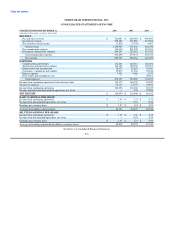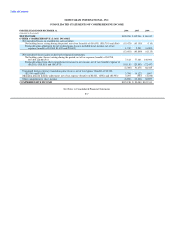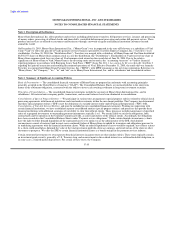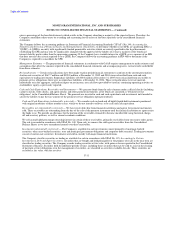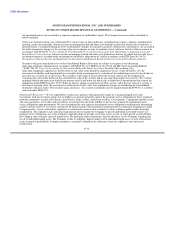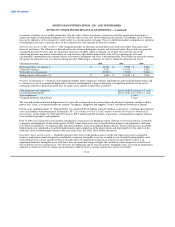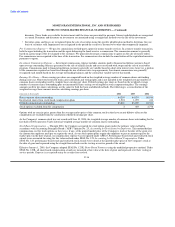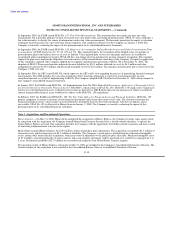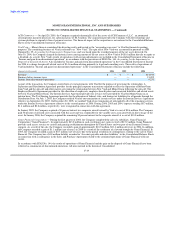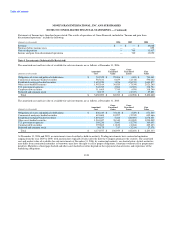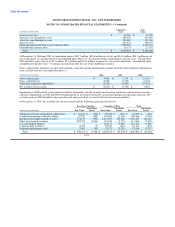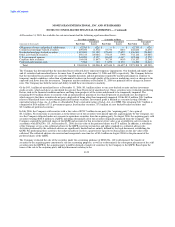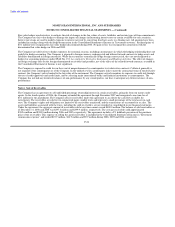MoneyGram 2006 Annual Report Download - page 71
Download and view the complete annual report
Please find page 71 of the 2006 MoneyGram annual report below. You can navigate through the pages in the report by either clicking on the pages listed below, or by using the keyword search tool below to find specific information within the annual report.
Table of Contents
MONEYGRAM INTERNATIONAL, INC. AND SUBSIDIARIES
NOTES TO CONSOLIDATED FINANCIAL STATEMENTS — (Continued)
investment securities are not readily marketable. The fair value of these investments is based on cash flow projections that require a
significant degree of management judgment as to default and recovery rates of the underlying investments. Accordingly, these estimates
may not be indicative of the amounts we could realize in a current market exchange. The use of different market assumptions or valuation
methodologies may have a material effect on the estimated fair value amounts of these investments.
Allowance for Losses on Receivables — The Company provides an allowance for potential losses from receivables from agents and
financial institutions. The allowance is determined based on known delinquent accounts and historical trends. Receivables are generally
considered past due two days after the contractual remittance schedule, which is typically one to three days after the sale of the
underlying payment instrument. Receivables are evaluated for collectibility and possible write-off by examining the facts and
circumstances surrounding each customer where an account is delinquent and a loss is deemed possible. Receivables are generally written
off against the allowance one year after becoming past due. Following is a summary of activity within the allowance for losses:
(Amounts in thousands) 2006 2005 2004
Beginning balance at January 1, $ 13,819 $ 7,930 $ 6,968
Charged to expense 3,931 12,935 6,422
Write-offs, net of recoveries (10,926) (7,046) (5,460)
Ending balance at December 31, $ 6,824 $ 13,819 $ 7,930
Property and Equipment — Property and equipment includes office equipment, software and hardware and leasehold improvements and
is stated at cost, net of accumulated depreciation. Property and equipment is depreciated using a straight-line method over the assets'
estimated useful lives. Estimated useful lives by major asset category are generally as follows:
Office furniture and equipment Lesser of the lease term or 7 years
Leasehold improvements Lesser of the lease term or 7 years
Agent equipment 3 years
Computer hardware and software 3 years
The cost and related accumulated depreciation of assets sold or disposed of are removed from the financial statements and the resulting
gain or loss, if any, is recognized under the caption "Occupancy, equipment and supplies" in the Consolidated Statement of Income.
For the years ended December 31, 2006 and 2005, we capitalized $14.8 million, and $12.3 million, respectively, of software development
costs in accordance with Statement of Position No. 98-1, Accounting for the Costs of Computer Software Developed or Obtained for
Internal Use. At December 31, 2006 and 2005, there is $39.9 million and $35.4 million, respectively, of unamortized computer software
costs included in property and equipment.
Prior to 2005, lease incentives received upon entering into certain leases for buildings (tenant allowances) were classified as a reduction
to property and equipment. In the fourth quarter of 2005, tenant allowances were reclassified from property and equipment to deferred
rent, which is included in "Accounts payable and other liabilities" in the Consolidated Balance Sheets. Tenant allowances for leasehold
improvements are capitalized as leasehold improvements upon completion of the improvement and depreciated over the shorter of the
useful life of the leasehold improvement or the term of the lease. See Note 15 for further discussion.
Intangible Assets and Goodwill — Goodwill represents the excess of the purchase price over the fair value of net assets acquired in
business combinations under the purchase method of accounting. Intangible assets are recorded at cost. Goodwill and intangible assets
with indefinite lives are not amortized, but are instead subject to impairment testing on an annual basis and whenever there is an
impairment indicator. Intangible assets with finite lives are amortized using a straight- line method over their respective useful lives of
four to fifteen years for customer lists, 36 to 40 years for trademarks and 15 years for patents. Intangible assets are tested for impairment
annually or whenever events or changes in circumstances indicate that its carrying amount may not be recoverable.
F-14




